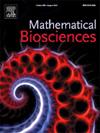Optimal control for an SIR model with limited hospitalised patients
IF 1.9
4区 数学
Q2 BIOLOGY
引用次数: 0
Abstract
This paper analyses the optimal control of infectious disease propagation using a classic susceptible–infected–recovered (SIR) model characterised by permanent immunity and the absence of available vaccines. The control is performed over a time-dependent mean reproduction number, in order to minimise the cumulative number of ever-infected individuals (recovered), under different constraints. We consider constraints on non-pharmaceutical interventions ranging from partial lockdown to non-intervention, as well as the social and economic costs associated with such interventions, and the capacity limitations of intensive care units that limits the number of infected individuals to a maximum allowed value. We rigorously derive an optimal quarantine strategy based on necessary optimality conditions. The obtained optimal strategy is of a boundary-bang type, comprising three phases: an initial phase with no intervention, a second phase maintaining the infected population at its maximum possible value, and a final phase of partial lockdown applied over a single interval. The optimal policy is further refined by optimising the transition times between these phases. We show that these results are in excellent agreement with the numerical solution of the problem.
对住院病人有限的 SIR 模型进行优化控制。
本文使用经典的易感-感染-康复(SIR)模型分析了传染病传播的最优控制,该模型的特点是永久免疫和缺乏可用疫苗。在不同的约束条件下,对随时间变化的平均繁殖数量进行控制,以最大限度地减少受感染个体(康复者)的累计数量。我们考虑了从部分封锁到不干预等非药物干预措施的约束条件,以及与这些干预措施相关的社会和经济成本,还有重症监护室的容量限制(将感染人数限制在允许的最大值)。我们根据必要的最优性条件严格推导出一种最优隔离策略。所得到的最优策略属于边界碰撞型,包括三个阶段:初始阶段不采取任何干预措施,第二阶段将受感染的人口数量维持在最大可能值,最后阶段在一个时间间隔内实施部分封锁。通过优化这些阶段之间的过渡时间,进一步完善了最优策略。我们的研究表明,这些结果与问题的数值解决方案非常吻合。
本文章由计算机程序翻译,如有差异,请以英文原文为准。
求助全文
约1分钟内获得全文
求助全文
来源期刊

Mathematical Biosciences
生物-生物学
CiteScore
7.50
自引率
2.30%
发文量
67
审稿时长
18 days
期刊介绍:
Mathematical Biosciences publishes work providing new concepts or new understanding of biological systems using mathematical models, or methodological articles likely to find application to multiple biological systems. Papers are expected to present a major research finding of broad significance for the biological sciences, or mathematical biology. Mathematical Biosciences welcomes original research articles, letters, reviews and perspectives.
 求助内容:
求助内容: 应助结果提醒方式:
应助结果提醒方式:


